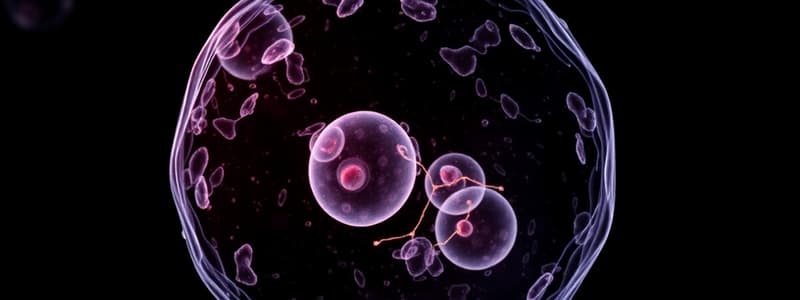Podcast
Questions and Answers
What is the primary purpose of mitosis in the cell cycle?
What is the primary purpose of mitosis in the cell cycle?
- To ensure that each daughter cell receives identical genetic material. (correct)
- To facilitate cellular growth without division.
- To break down the nuclear envelope.
- To allow cells to enter interphase.
Which phase of mitosis involves the alignment of chromosomes at the cell's equator?
Which phase of mitosis involves the alignment of chromosomes at the cell's equator?
- Prophase
- Metaphase (correct)
- Anaphase
- Telophase
What structure do spindle fibers attach to during mitosis?
What structure do spindle fibers attach to during mitosis?
- Centrioles
- Nuclear envelope
- Chromatin
- Kinetochore (correct)
What happens during anaphase of mitosis?
What happens during anaphase of mitosis?
What occurs during prophase?
What occurs during prophase?
Which structure is responsible for moving to opposite ends of the cell during prophase?
Which structure is responsible for moving to opposite ends of the cell during prophase?
What is the final phase of mitosis?
What is the final phase of mitosis?
How do chromosomes ensure accurate genetic material distribution during cell division?
How do chromosomes ensure accurate genetic material distribution during cell division?
What occurs during the G1 phase of interphase?
What occurs during the G1 phase of interphase?
What happens to the chromosomes during telophase?
What happens to the chromosomes during telophase?
Which phase directly follows the S phase in interphase?
Which phase directly follows the S phase in interphase?
Why is interphase considered one of the most important processes in the cell cycle?
Why is interphase considered one of the most important processes in the cell cycle?
What is the main function of the checkpoints during interphase?
What is the main function of the checkpoints during interphase?
What is the result of cytokinesis?
What is the result of cytokinesis?
What occurs in the G2 phase of interphase?
What occurs in the G2 phase of interphase?
Flashcards are hidden until you start studying
Study Notes
The Cell Cycle: Interphase and Mitosis
- The cell cycle consists of two main phases: interphase and mitosis (M phase).
- Interphase is the preparatory stage before mitosis, including G1, S, and G2 phases.
- Mitosis is the process of cell division resulting in two identical daughter cells.
Interphase
- Cells spend most of their lifetime in interphase.
- Interphase prepares the cell for division through growth and DNA replication.
- Interphase comprises three stages: G1, S, and G2 phases.
G1 Phase
- The longest phase of interphase; cell growth occurs.
- The cell either commits to division or exits the cycle at the restriction point.
S Phase
- DNA replication (synthesis) takes place.
- Each chromosome is duplicated forming two sister chromatids connected at the kinetochore.
G2 Phase
- Continued cell growth and organelle replication.
- The cell prepares for mitosis.
Checkpoints
- Cells pass through checkpoints at the G1, S and G2 phases.
- Checkpoints assess cell structure for damage and receive signals from other cells, regulating cell division.
Mitosis Stages
- Mitosis divides the nucleus into two identical nuclei.
- Stages include prophase, metaphase, anaphase, and telophase.
- Cytokinesis, the division of the cytoplasm, follows telophase, completing cell division.
Prophase
- Chromosomes condense; nuclear envelope breaks down.
- Centrioles move to opposite poles; spindle fibers begin to form, attaching to kinetochores.
Metaphase
- Chromosomes align along the cell's equator (metaphase plate).
- Spindle fibers attach to each chromosome's kinetochore.
Anaphase
- Sister chromatids separate and move to opposite cell poles.
- The cell elongates.
Telophase
- Nuclear envelopes reform around separated chromosomes.
- Chromosomes decondense.
- Spindle fibers disassemble.
- The cell begins to pinch inward.
Cytokinesis
- Cytoplasm divides, resulting in two identical daughter cells (each with 46 chromosomes).
- The daughter cells then enter interphase.
The Purpose of Interphase
- Interphase is crucial for cell growth, organelle synthesis, and preparation for mitosis.
- Without interphase, subsequent cell division phases wouldn't occur.
Studying That Suits You
Use AI to generate personalized quizzes and flashcards to suit your learning preferences.




